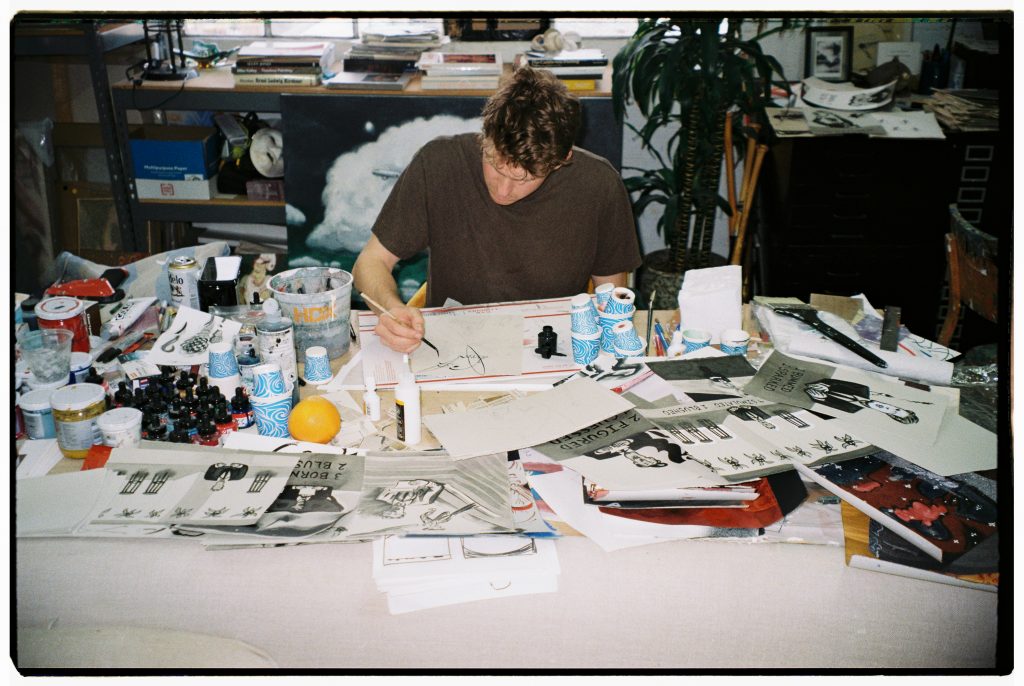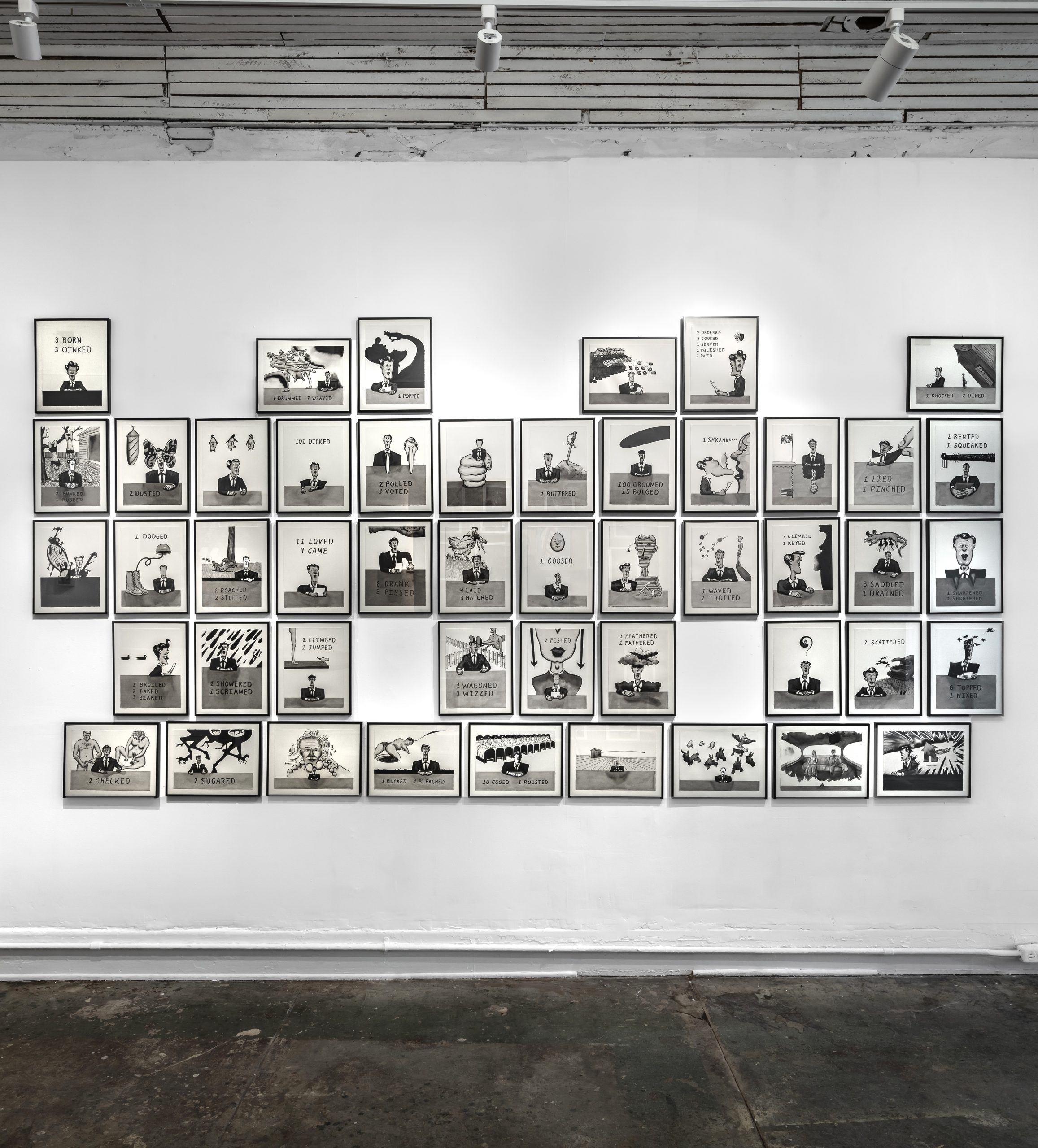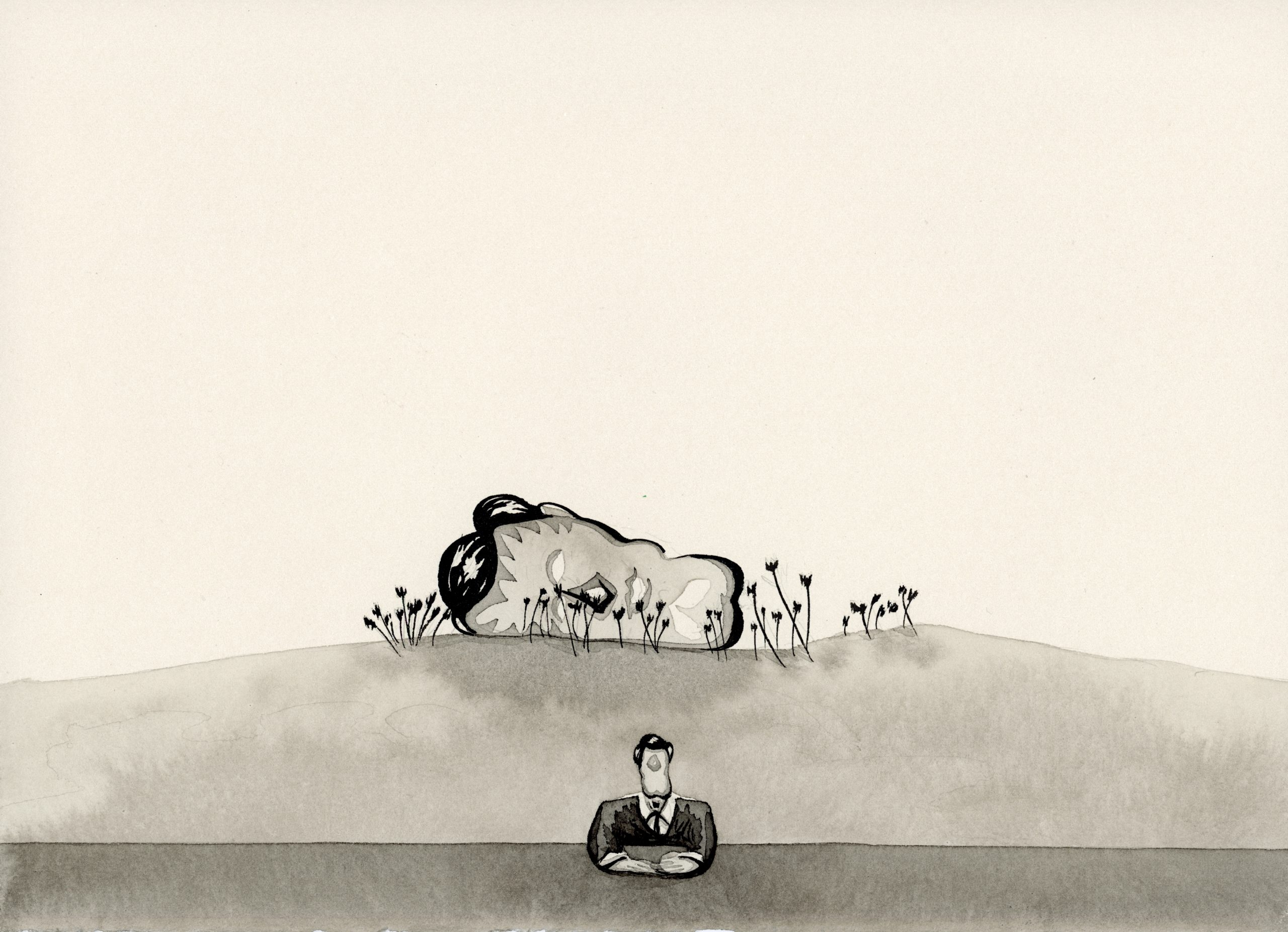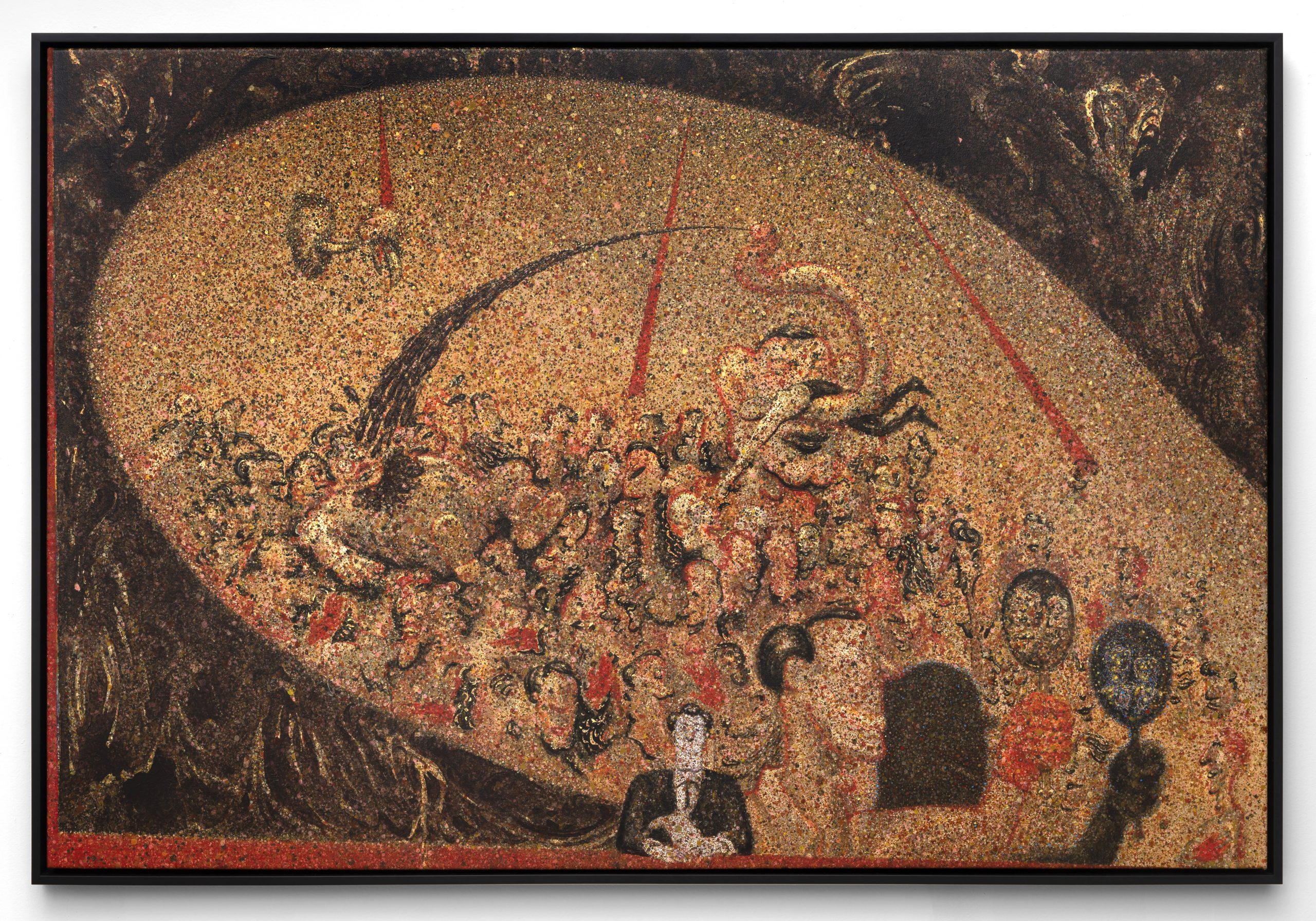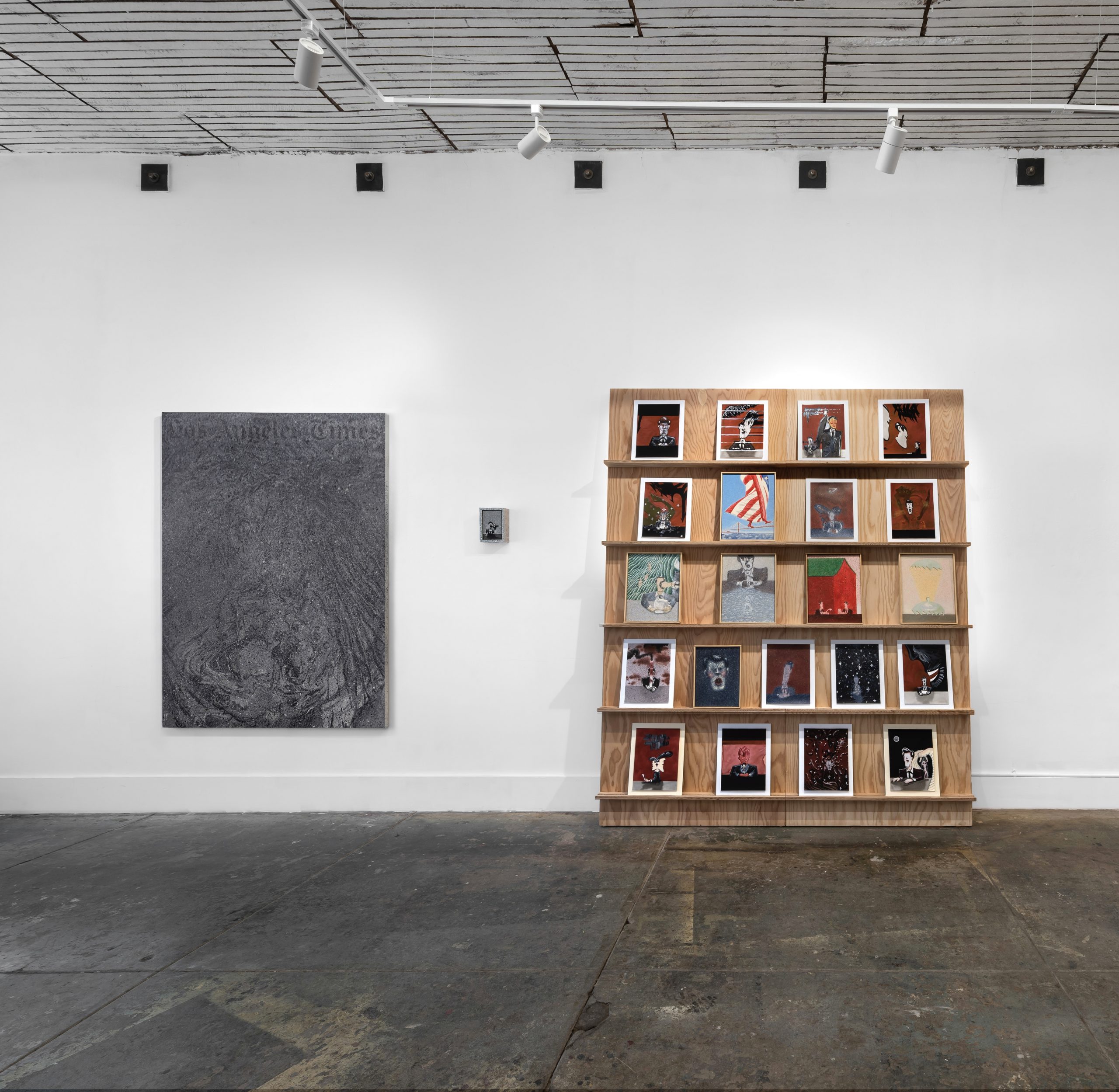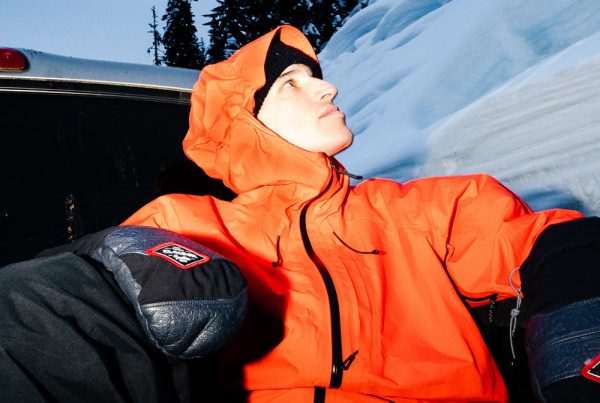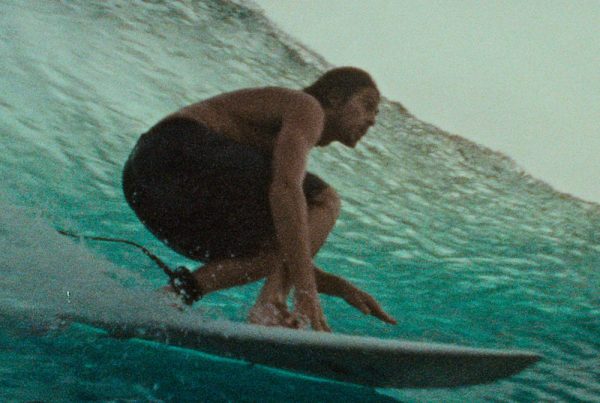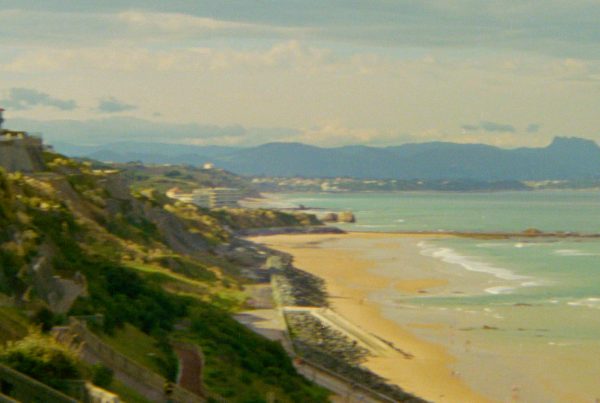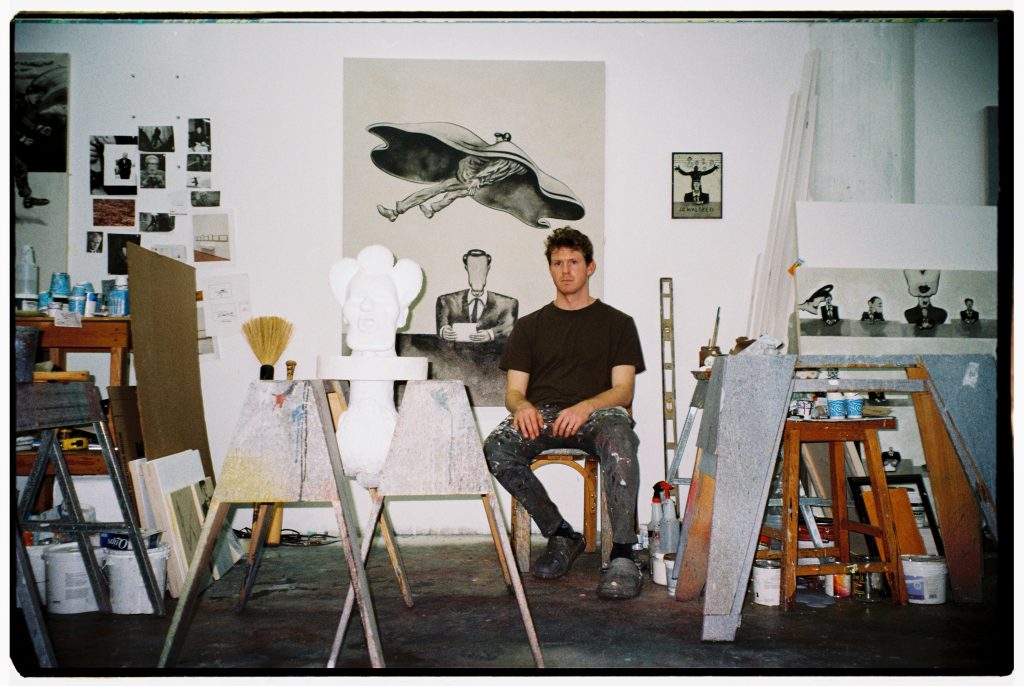
Photography and Interview by Robin Pailler | Artwork Photography by Gene Ogami
I first met Jackson Casady through Rowan Zorilla‘s local baseball team, the Los Angeles Creamers from South Pasadena.
While shooting Vista Virtues, Rowan invited me to a game and introduced me to his teammates. Jackson was one of the first to greet me, with all the characteristics I’ve come to learn are indicative of his nature: welcoming, witty, inquisitive, a beaming smile, a cold Modelo in hand. Yet somewhat of an enigma.
So, upon revisiting the Creamers this spring, fresh from their 2024 championship success, I should add – I was surprised, yet not surprised, to learn that Jackson is, in fact, an artist. A painter. A sculptor. Dare I say, a satirist? So on the eve of his latest exhibition of work entitled “The Fourth Estate,” at the Ysasi Gallery in Los Angeles, I visited Jackson’s studio to gain a deeper insight into his world.
From playing baseball with pro skaters to working production on the Oscars, from surfing with Noah Collins on the same high school team to creating ambitious art exhibitions, ladies and gentlemen: Mr. Jackson Casady.
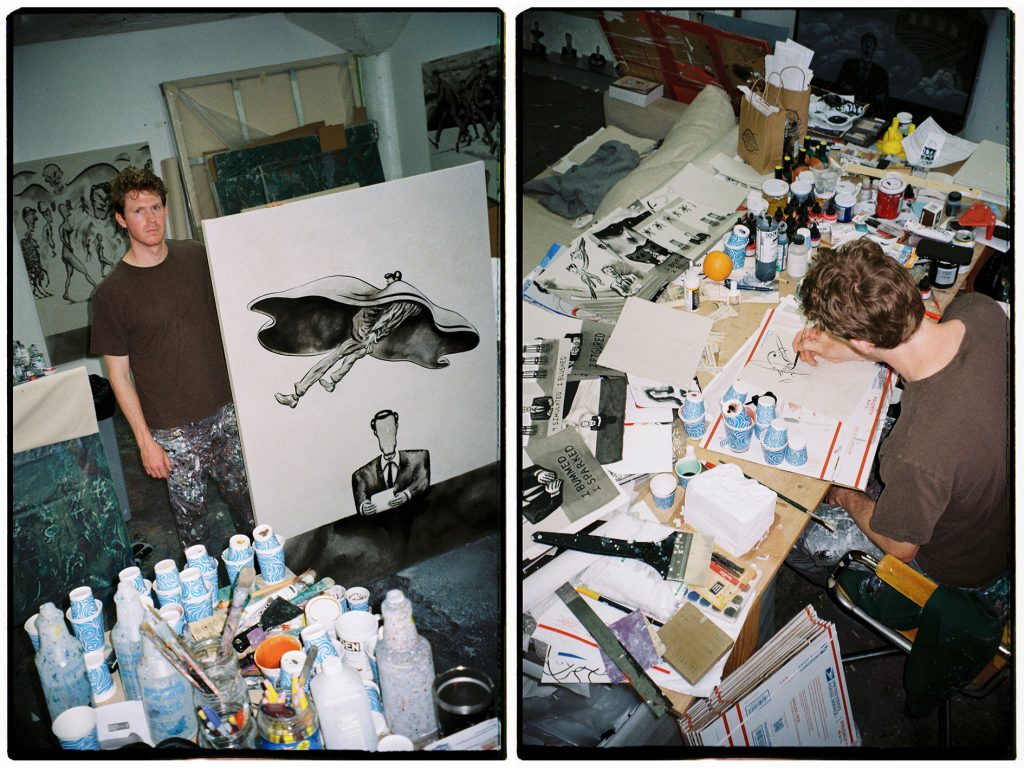
For those who don’t know, can you introduce yourself?
Sure. I’m Jackson Casady. I’m an artist working in Los Angeles. I’m here with Robin at my studio in downtown LA. We just had a cigarette.
So, born and raised in LA. Tell me how the arts started for you.
Art has always been a part of my life. Always been drawing and making things since I was young. I was the illustrator for the school newspaper, making beachscapes as a teenager, learning how to move paint around. Copying Pettibon and George Bellows. My mom was artistic and went to UCLA for art. She’s always encouraged me. My dad worked in television and dabbled as a musician too. He was friends with some great artists back in the ’70s and brought me to see Ed Ruscha’s “Psycho Spaghetti Westerns” show in 2011. That energized me. I thought about going to art school, and it was an option. But I chose to go pretty far away from home to the University of Virginia for college. It was a change of pace and a personal adventure.
What did you graduate in?
I earned a business and an art degree, mainly focused on painting. The double major was a lot. I enjoyed the academic challenge at UVA, but me and business school didn’t really see eye-to-eye. It made my decision clear to keep painting. I completed an art thesis exhibition, which is the first serious thing art majors do, and it was about award shows – very satirical – and influenced by James Ensor. Even while I was in Virginia, I was making paintings about LA. After graduating, I bartended that summer, then scurried back to California. It felt like that’s where a career could happen, plus I could live at home and paint out of the garage. I needed somewhere to start.
Would you consider yourself a full-time artist now?
Yeah, for sure. I try to get into the studio as much as possible. I still do some part-time work in production. It’s a hustle. I’ve done PA jobs on various awards: the Grammys, the Oscars, etc., which I see as “research” for my paintings.
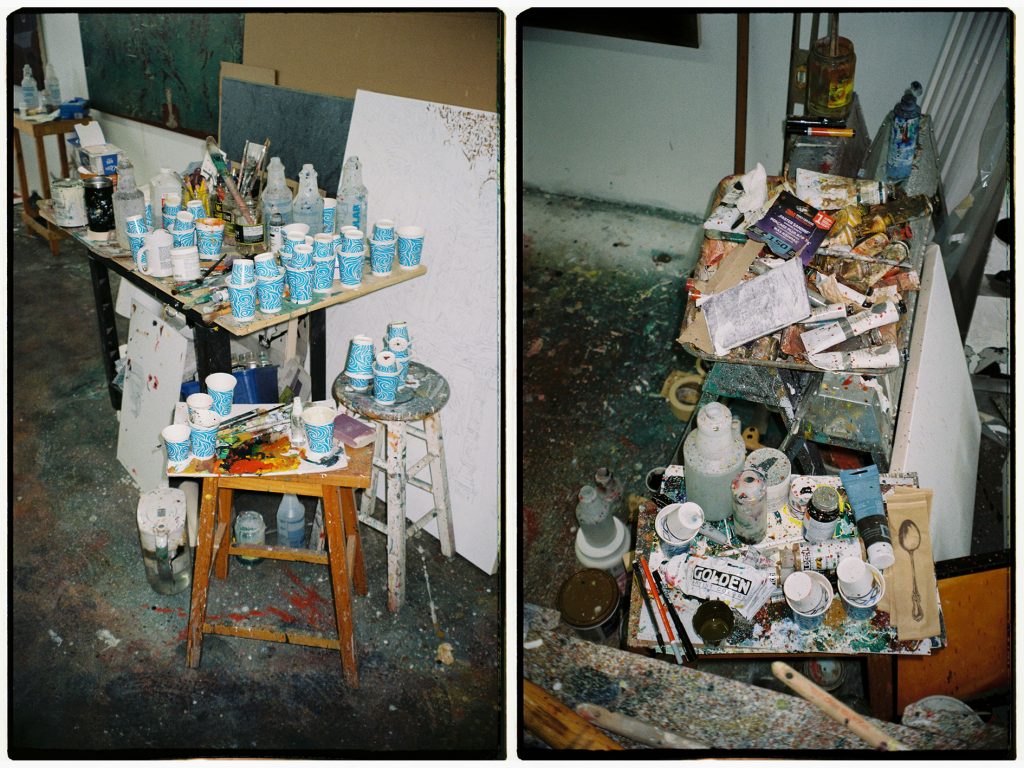
When was the moment when you felt you achieved recognition or at least some form of success as an artist?
That would be in 2020 when I had my first solo show at Richard Heller Gallery. Even though it was during COVID, a lot of artists did really well. So that was a big moment for me because I had a lot of work saved up… It was like a first album. I gotta thank Chris Rexrod and Charlie Roberts for first showing my work at 0-0 Gallery (RIP) in Chinatown and introducing me to Richard. That was the spark.
And ever since you’ve been a burgeoning and successful artist.
(Laughs) Well.. success, I guess, is still making work in my opinion. Keeping the studio going, despite how expensive it all is. And having ambitious shows is something I’m proud of. Maybe I’m on the slow burn, growing organically. I don’t want to feel pressure to make a certain thing. Exploring different series and not being pigeonholed would be another layer of success.
I find there’s a very satirical and surreal element to a lot of your work. Where does that stem from?
Oh yeah, the surreal thing. I think it comes from trying to convey an experience more than a style. I just want it all to be a bit unexpected or surprising. I guess surrealism comes from dreams. The unconscious. But my work doesn’t come from dreams. Usually, an idea jumps out, and that’s what I tweak and mess with. I’m definitely drawn to things that are a little more offbeat. There’s a simmering joke in some of the narratives. It’s not full-on. This recent show about the news anchor and the press is definitely satirical. So, whether it’s the news or entertainment, I’m leaning into the absurdity and finding humor in that world, which tends to be so ironically black and white.

It’s funny, you also mentioned you work as a PA, a lot of your art feels like it exists within show business.
Yeah, I guess it’s just an interest of mine and the world my father introduced me to at a young age. From my limited experience in the industry, I think that’s the most honest thing I can paint. It’s familiar and something I have thoughts about and know the behind-the-scenes of. I can dig into it. Like when we’ve spoken before about Jimmy Glick—it’s so exaggerated and big, but based in something real. Martin Short observed these characters at press junkets and then deconstructed them. Made it his own. That’s what I try to do with my work. Take something that interests me, whether it be a host or a news anchor, and embellish them and be deprecating. I’ve landed on this way of rendering figures. There’s a whole history of cartooning or caricaturing the figure. And I’m doing that, walking that path. I embellish certain features, the Adam’s apple, the coiffed hair, and the butt chin. The suits they’re in present as serious, but it’s hilarious, too.
Tell us about this series of work and your latest show at Ysasi Gallery.
So, the show is called The Fourth Estate. It’s a name given to the press and media that inundates my life, our lives. A news anchor is kinda the main symbol and throughline for the show. He is stationed at the bottom of every image. Staring at and addressing the viewer. It felt like a fresh way to paint figuratively. I think the expectation is that the anchor presents serious stories. And my anchors, they don’t give any real news narratives and don’t give any answers; they ask more questions. These scenes happen behind them. They have no control over it. I also made so many drawings, too. That relentless production and repetition felt like my experience of the news landscape. I guess I was making escapist art about the thing I want to escape. These drawings are definitely the most blatant satirical gesture in the show. I chose a specific gray paper and black ink to recall the palette of newsprint. And I tried to confront and flatten the hierarchy of information in newspapers, taking the bold, front-page headlines, and degrading them with the visual language of the back-page comics.
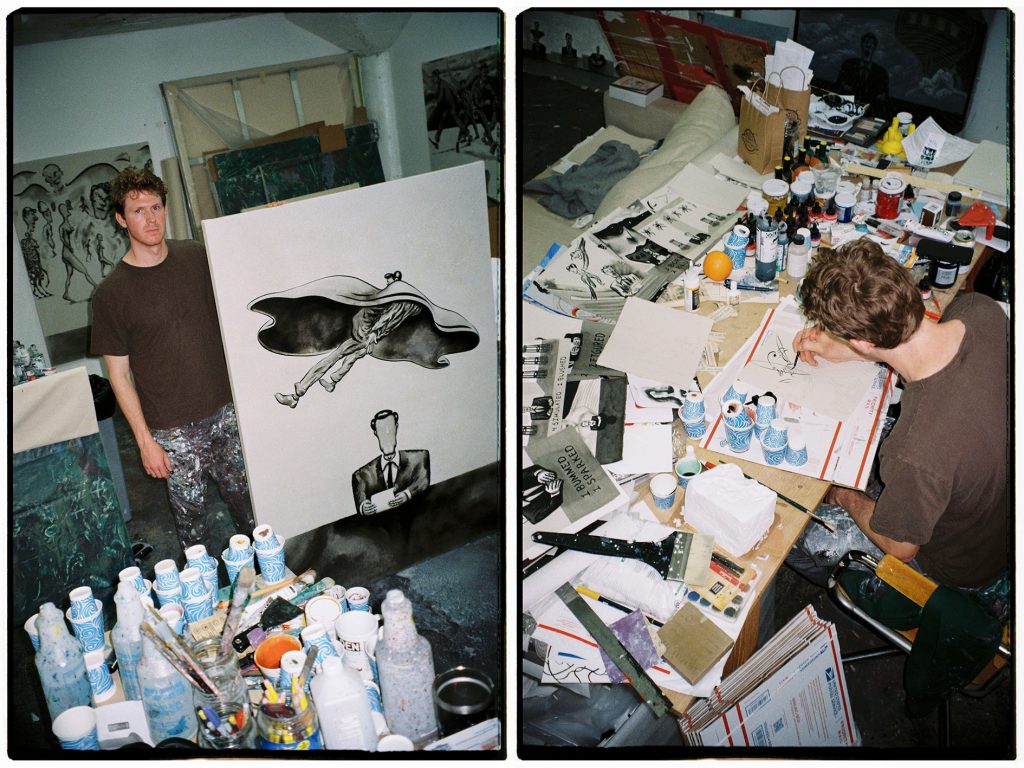
I wanted to ask how much of it is influenced by mainstream news in America? I think it’s perhaps the only country in the world where the news anchors have almost become celebrities themselves. Whether Anderson Cooper or Tucker Carlson, they sort of feed this celebrity image of themselves.
And Jon Stewart, who plays both comedian and newsman. Some of them have a more serious reputation than others, as you know. With the big network anchors, sometimes I think you can’t believe they even believe what they’re saying. They’re journalists, of course, and provide a check on those in power. But they’ve also become punching bags. Obviously, both sides are guilty of perpetuating their side of the story. And I’m not trying to be political. I mean, politics is a huge part of our news cycle. My idea is to comment on the figures who create these political identities, whether they’re trying to tell the truth or purposely manipulate it.
And is that a conscious decision?
Yeah, I don’t think the political stripes are what’s interesting about the news anchor figure. It’s that they’re a messenger. One of my influences was Honoré Daumier, a French artist, satirist, and printmaker. And an untrained sculptor. I drew inspiration for my work from his crude sculptures. I didn’t want to reference politicians of our time, but instead lean into the news anchor as a timeless archetype.
And despite it not being political, it does remind me of Good Night, and Good Luck (2005).
Oh yeah, Edward R Murrow’s sign off was “Good night, and good luck”. He became famous for taking on Joe McCarthy in the 1950s. I reference that quote in the titles of two paintings.

Right, using his platform to take on McCarthyism, which was essentially a witch-hunt of Communism post World War II.
And there’s a little bit of that echoed today, like there’s a figurehead at the center of a party who’s spouting a lot of disinformation, and there’s also a desperate attempt to call that out.
How do you feel about the state of American politics right now?
I’m not proud of the state of things, but I wanted this show to be less political and more about processing a relentless news cycle. There is contrived urgency that comes from 24-hour news. Everything is meant to be breaking or important. But it’s invented.
Is there a reason some of the anchors are faceless?
They don’t need a face. I guess they become universal without those features. There’s something slightly menacing about them, and maybe haunting? Even though this figure is supposed to give us comfort and help us understand what is going on. My anchors push levity.
Going back to growing up. I hear you went to high school with Noah Collins? One of our treasured WT affiliates. What was Noah like in school?
Noah was definitely one of those standout surfing talents. We met on the Mira Costa surf team. He would clean up, take first place in the shortboard category. Meanwhile, on the other side of the pier, my brother and I bodyboarded and would win our heats, too. He’s killing it with his design studio. And it’s refreshing to see dudes from the South Bay bubble take this creative path.
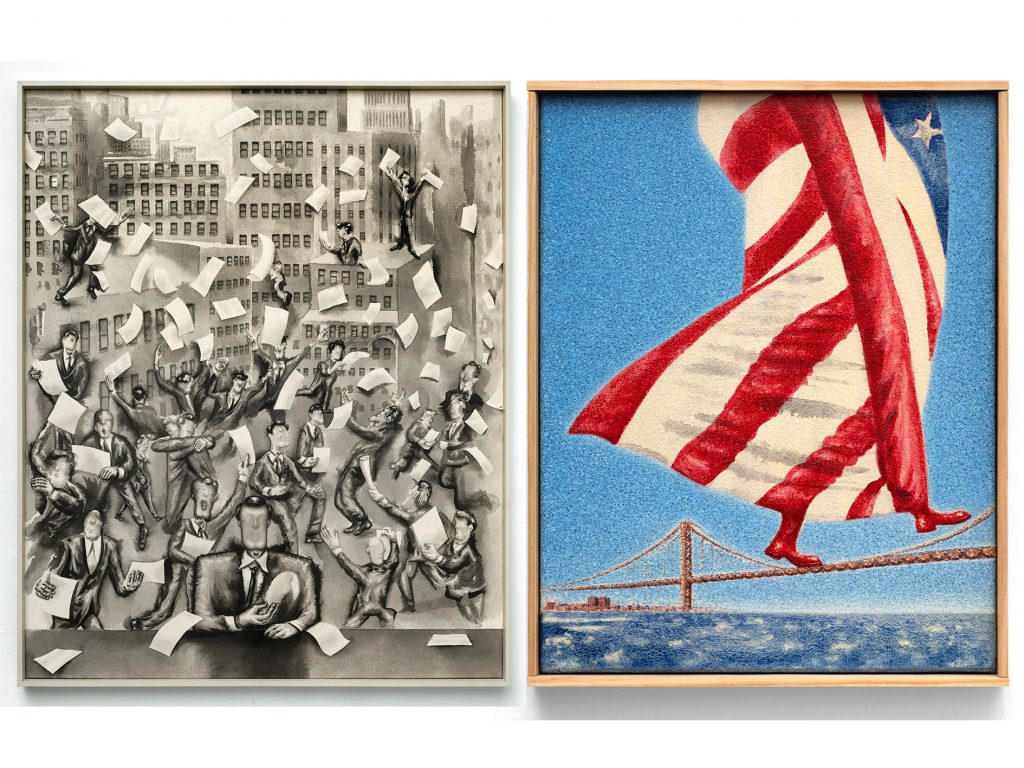
How did you get into bodyboarding?
We just started getting into the water, the ocean was a mile away, so we just got out there. I surf now, but I got comfortable in the water on a bodyboard. Spent a lot of time doing it. Got embarrassingly good at dick dragging (laughs). But, I’m surfing more now and have a 6’6 short board and a longboard. A foamy too. Just having fun. It’s relaxing and a good way to hang with people. It can also be intense. I don’t usually get out there when it’s super big, but I see guys like Noah charging, and that’s awesome. I’m chilling and like a lil head high or a tad overhead ideally. But when you get a good one of those, it sustains you. Maybe painting is like that, too. If you make just one good drawing or painting, it leads you down this road to keep pushing that idea. I don’t think I needed to make an analogy of painting and surfing (laughs). But I just tried.
Would you say surfing is a passion? Do you watch surf videos to keep up with it all?
Oh yeah, I try to follow it. I was in Hawaii when the Pipe Masters was called on and we got to witness it. That was truly incredible to see it go off in person. Tosh Tudor and Mikey February had a heat together and got swallowed by Pipe with style. Mason Ho was late for his heat, but it didn’t matter. He just bungled out to the beach, got through the lineup super quick, and then got spat out of a huge, huge wave and probably won his heat. So casual.
Baseball also seems to be an interest of yours. Playing for the Creamers. How did that come about?
I grew up playing, loved it, and hated it at times. But yeah, I play in a wood bat league in South Pasadena called “The Creamers.” The horniest team. It’s a big part of my life now, and I never thought I would be playing baseball in my thirties. But it’s not too serious; we drink beer while we play. Still, we’re all pretty good. Fundamentally sound for sure. Grant Gutierrez, el capitán, who’s an artist, photographer, sculptor, all-round good dude, etc., recruited me. I was rusty, but so glad I started up again. The Creamers have a ton of fun out there, and it’s a solid group. The skater jerk-off boys are kinda the best athletes, like Travis Harrison, Boosh, Delon, France, and Rowan Zorilla. I never really skated.. was more the type to try riding a dolphin in the water.
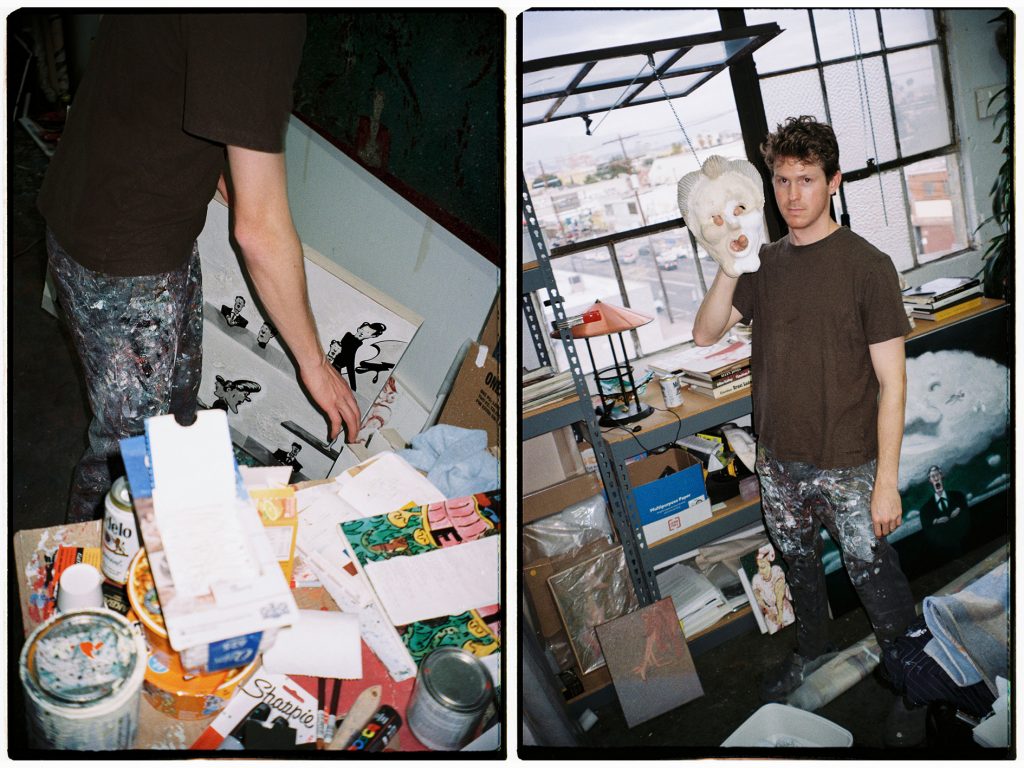
Jesse Alba is on the team, too.
Jesse’s so funny and can do it all. He hits to the opposite field really well, pitches a crazy eephus, and plays kinda everywhere. And he humps everything between the chalk.
Did you know those guys before joining the Creamers?
I knew Grant, but no one else really. Over the past couple seasons, we’ve all become very close. A bunch of them came to my wedding. And the cupeth of creameth overfloweth.
Where were you when the Dodgers won the 2024 World Series?
I was at the Roost with a bunch of the Creamers. It was packed, and there may have been some slight damage done to the bar from our celebrating (laughs). But the Creamers didn’t torch that city bus. Just saying. The Dodgers were so stacked. We followed them all year, and when your team wins, it’s the best feeling. My buddy, Chris Taylor, was on that team, so we were excited for him and the entire city. A bunch of us went to the parade. It was surreal, millions of people in the streets. The players driving through. The trophy hoisted. And then it for sure inspired the Creamers to win their own championship later that summer.
So baseball, surfing, and painting these days. Anything else we should look out for?
Yeah, that’s the big three. I’m really excited about my latest show, and I hope people can come see it in person in LA. It has a lot of everything: drawing, painting, sculpture, animations, farm animals, sex, pills, genitalia… Bring the whole family.
